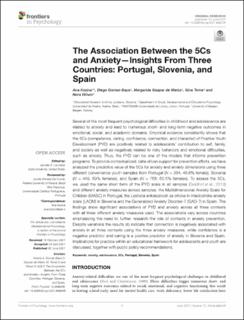| dc.contributor.author | Kozina, Ana | |
| dc.contributor.author | Gomez-Baya, Diego | |
| dc.contributor.author | Gaspar de Matos, Margarida | |
| dc.contributor.author | Tome, Gina | |
| dc.contributor.author | Wiium, Nora | |
| dc.date.accessioned | 2021-11-29T07:59:52Z | |
| dc.date.available | 2021-11-29T07:59:52Z | |
| dc.date.created | 2021-06-24T20:20:35Z | |
| dc.date.issued | 2021 | |
| dc.identifier.issn | 1664-1078 | |
| dc.identifier.uri | https://hdl.handle.net/11250/2831792 | |
| dc.description.abstract | Several of the most frequent psychological difficulties in childhood and adolescence are related to anxiety and lead to numerous short- and long-term negative outcomes in emotional, social, and academic domains. Empirical evidence consistently shows that the 5Cs (competence, caring, confidence, connection, and character) of Positive Youth Development (PYD) are positively related to adolescents’ contribution to self, family, and society as well as negatively related to risky behaviors and emotional difficulties, such as anxiety. Thus, the PYD can be one of the models that informs prevention programs. To provide contextualized, data-driven support for prevention efforts, we have analyzed the predictive value of the 5Cs for anxiety and anxiety dimensions using three different convenience youth samples from Portugal (N = 384, 46.6% female), Slovenia (N = 449, 69% females), and Spain (N = 768; 60.5% females). To assess the 5Cs, we used the same short form of the PYD scale in all samples (Geldhof et al., 2013) and different anxiety measures across samples: the Multidimensional Anxiety Scale for Children (MASC) in Portugal, the Lestvica anksioznosti za otroke in mladostnike anxiety scale (LAOM) in Slovenia and the Generalized Anxiety Disorder-7 (GAD-7) in Spain. The findings show significant associations of PYD and anxiety across all three contexts with all three different anxiety measures used. The associations vary across countries emphasizing the need to further research the role of contexts in anxiety prevention. Despite variations the results do indicate that connection is negatively associated with anxiety in all three contexts using the three anxiety measures, while confidence is a negative predictor and caring is a positive predictor of anxiety in Slovenia and Spain. Implications for practice within an educational framework for adolescents and youth are discussed, together with public policy recommendations. | en_US |
| dc.language.iso | eng | en_US |
| dc.publisher | Frontiers Media | en_US |
| dc.rights | Navngivelse 4.0 Internasjonal | * |
| dc.rights.uri | http://creativecommons.org/licenses/by/4.0/deed.no | * |
| dc.title | The Association Between the 5Cs and Anxiety—Insights From Three Countries: Portugal, Slovenia, and Spain | en_US |
| dc.type | Journal article | en_US |
| dc.type | Peer reviewed | en_US |
| dc.description.version | publishedVersion | en_US |
| dc.rights.holder | Copyright 2021 Kozina, Gomez-Baya, Gaspar de Matos, Tome and Wiium | en_US |
| dc.source.articlenumber | 668049 | en_US |
| cristin.ispublished | true | |
| cristin.fulltext | original | |
| cristin.qualitycode | 1 | |
| dc.identifier.doi | 10.3389/fpsyg.2021.668049 | |
| dc.identifier.cristin | 1918292 | |
| dc.source.journal | Frontiers in Psychology | en_US |
| dc.identifier.citation | Frontiers in Psychology. 2021, 12, 668049. | en_US |
| dc.source.volume | 12 | en_US |

